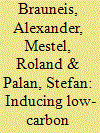|
|
|
Sort Order |
|
|
|
Items / Page
|
|
|
|
|
|
|
| Srl | Item |
| 1 |
ID:
150055


|
|
|
|
|
| Summary/Abstract |
This paper studies various options to support allowance prices in the EU Emissions Trading System (ETS), such as adjusting the cap, an auction reserve price, and fixed and variable carbon taxes in addition to the EU ETS. We use a dynamic computable general equilibrium model that explicitly allows for allowance banking and for a detailed cost-effectiveness analysis at the EU Member State level. We find that tightening the cap provides an ad hoc solution to the fundamental issue of the robustness of the effective carbon price, while introducing a price component to the ETS brings structural carbon price support in times of negative demand shocks for emission allowances. These price-based policies still benefit from the intertemporal flexibility through the banking provision in the EU ETS by re-allocating emissions over time with stronger emission reductions in early years and emission increases in later years. A higher emission price has a larger negative impact on the new Member States' economies than on other Member States. Furthermore, introducing a carbon tax in addition to the EU ETS decreases the price of allowances, resulting in welfare gains for net buyers of allowances while net sellers are worse off.
|
|
|
|
|
|
|
|
|
|
|
|
|
|
|
|
| 2 |
ID:
117318


|
|
|
|
|
| Publication |
2013.
|
| Summary/Abstract |
Uncertainty about long-term climate policy is a major driving force in the evolution of the carbon market price. Since this price enters the investment decision process of regulated firms, this uncertainty increases the cost of capital for investors and might deter investments into new technologies at the company level. We apply a real options-based approach to assess the impact of climate change policy in the form of a constant or growing price floor on investment decisions of a single firm in a competitive environment. This firm has the opportunity to switch from a high-carbon "dirty" technology to a low-carbon "clean" technology. Using Monte Carlo simulation and dynamic programming techniques for real data, we determine the optimal CO2 price floor level and growth rate in order to induce investments into the low-carbon technology. We find that a carbon price floor can be used to induce earlier low-carbon technology investment and show this result to be robust to a large variety of input parameter settings.
|
|
|
|
|
|
|
|
|
|
|
|
|
|
|
|
| 3 |
ID:
121384


|
|
|
|
|
| Publication |
2013.
|
| Summary/Abstract |
This paper considers several policy options which have been proposed to improve the functioning of the ETS. These options require an intervention either on the ETS cap (-30% target, set-aside, carbon central bank, long-term target) or on the carbon price (European and national price floor). We analyse the impact of each policy on the ETS carbon price and emissions. A multi-criteria evaluation method is applied to compare the policy options against a plurality of environmental, economic and procedural criteria. We find that the final ranking depends on the goals to be achieved, i.e., the relative weights attributed to the criteria. When policymakers want mainly to support the carbon price both in the short and long-run, while improving ETS flexibility and harmonization, the CCB and the EU price floor are, respectively ranked as first and second-best options. As the preference for environmental and implementation goals gradually increases, the position of the EU price floor and CCB options tend to invert. The -30% target should be adopted when reducing emissions is the priority goal, while a national price floor is the worst option, in this case. Nevertheless, self-interested States looking for a relatively quick, feasible solution, may find it optimal.
|
|
|
|
|
|
|
|
|
|
|
|
|
|
|
|
| 4 |
ID:
103479


|
|
|
|
|
| Publication |
2011.
|
| Summary/Abstract |
Price floors in greenhouse gas emissions trading schemes can guarantee minimum abatement efforts if prices are lower than expected, and they can help manage cost uncertainty, possibly as complements to price ceilings. Provisions for price floors are found in several recent legislative proposals for emissions trading. Implementation however has potential pitfalls. Possible mechanisms are government commitments to buy back permits, a reserve price at auction, or an extra fee or tax on acquittal of emissions permits. Our analysis of these alternatives shows that the fee approach has budgetary advantages and is more compatible with international permit trading than the alternatives. It can also be used to implement more general hybrid approaches to emissions pricing.
|
|
|
|
|
|
|
|
|
|
|
|
|
|
|
|
|
|
|
|
|